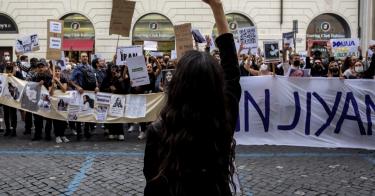In January 2016, then-Iranian President Hassan Rouhani visited Rome on a European tour designed to gin up investment in his country after the Joint Comprehensive Plan of Action (JCPOA) lifted sanctions on such economic activity. In an embarrassing fit of political correctness at a state dinner in the Capitoline Museum, his Italian hosts placed boxes around their nude classical statues so Mr. Rouhani’s strict Muslim eyes would not be offended.
Today, the Capitoline sports a new look: A monumental official banner over this sacred site for ancient Roman liberty proclaiming solidarity with Iranian women seeking their freedom. What a difference seven years makes.
The 2016 episode was particularly craven because of the ancient history of Capitoline Hill. The Romans had erected a bronze statue on the Capitoline to commemorate the heroism of the sixth-century B.C. founder of the Republic, Lucius Junius Brutus, in perpetuity.
After the rape by a royal prince and subsequent suicide of his best friend’s wife, Lucretia, Brutus pledged to expel the despotic kings of Rome, which established the republic. When he discovered his own sons were plotting to restore the monarchy, he had them executed for treason, thereby preserving it. The statue of Brutus, and the Capitoline more broadly, became the civic heart of the Roman Republic.
In the course of Renaissance renovations on the site directed by Michelangelo, an austere Republican-era bronze head was recovered that was immediately judged to be the original Brutus. The statue is now in the Capitoline Museum where Mr. Rouhani had his dinner during which the Italian authorities were all too eager to censor their own cultural heritage to curry favor with the Islamic Republic, then fat with funds from the JCPOA sanctions relief.
The anticipated contracts did not come to pass due to the Trump administration’s exit from the nuclear deal and pursuing a policy of maximum economic pressure on Iran, but the assumption going into the reprised JCPOA negotiations under the Biden administration was that they would be on the table once again.
Two months ago, however, the game may have changed. Another young woman, Mahsa Amini, was like Lucrezia brutalized at the hands of the authorities_in this case, beaten to death by the Iranian regime’s “morality police” in Tehran for the improper fit of her hijab. Her murder in late September sparked broad popular protests in Iran that, while compelling, were at first judged by conventional wisdom to be only the most recent wave of unrest that would be duly put down by the oppressive Islamic Republic regime.
Yet the protests show no signs of abating. And the protesters are now demanding not merely reforms, but a full change of government. Focused on women’s rights, they are extending across the country to a wide range of ethnicities and economic classes. The Iranian people are receiving unprecedented support around the world from those who value freedom more than potential reconstruction contracts in the event of another iteration of the nuclear deal.
In fact, recent polling indicates that even President Biden’s domestic supporters in the U.S. now prioritize human rights in Iran over rejoining the JCPOA. French President Emmanuel Macron, one of the staunchest supporters of the JCPOA, has recently declared that the political situation in Iran makes it impossible to revive the framework for a new nuclear deal.
The Biden administration, however, has been comparatively tepid and timid in their response to the protests in their dogged hopes of reviving the JCPOA. Iranian President Ebrahim Raisi was issued a visa to visit the U.N. General Assembly in New York in the days after the Amini murder, where he used his time at the lectern to lecture the West about human rights. Even while paying lip service to support the protesters, senior officials insist that this is not inconsistent with continuing the nuclear deal negotiations that would only entrench and enrich their oppressors.
The Romans appear to be made of sterner stuff. Their new dynamic has taken the form of the large banner on the Capitoline marked with the crest of the city of Rome and reading, “Con le donne iraniane per la liberta.” Gone are the days of betraying Western civilization to do deals with the brutal dictatorship in Tehran as the heirs of Brutus and Lucrezia make common cause with the brave Iranian patriots fighting for their freedom. Hopefully, Washington will take note.
This piece originally appeared in The Washington Times




